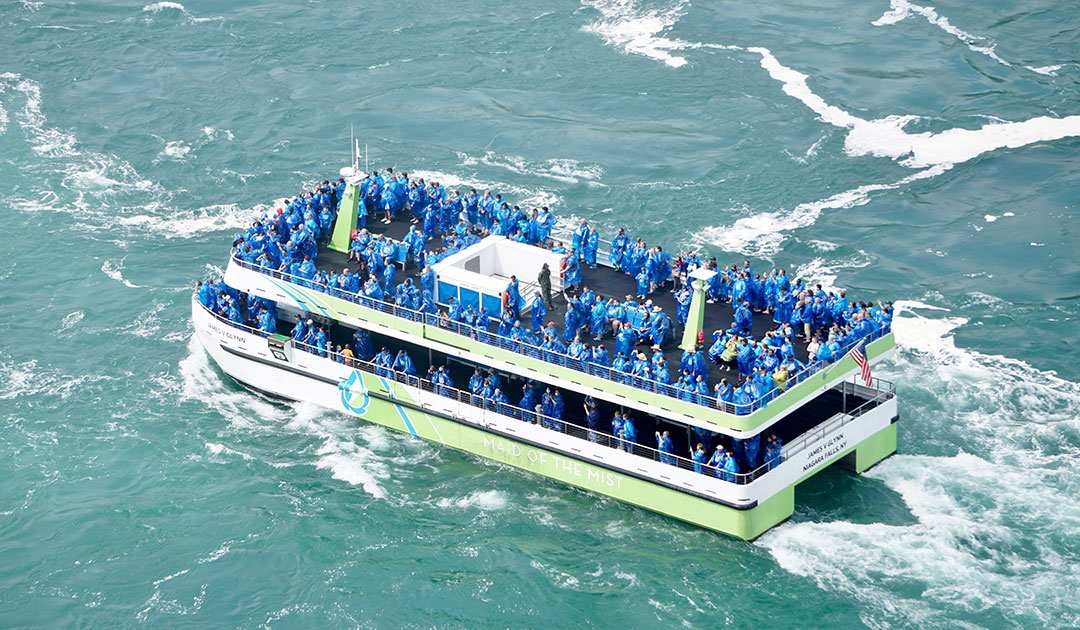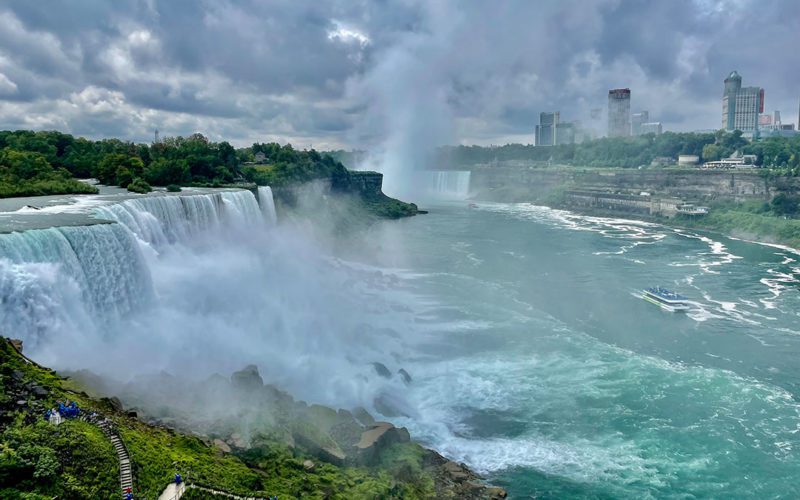
On a drizzly summer morning, Capt. Kaitlynn McHenry guided Maid of the Mist’s James V. Glynn off the dock in Niagara Falls State Park. Instead of rumbling engines, the vessel got underway with a subtle whoosh.
The 90.5-foot catamaran James V. Glynn and its sister vessel, Nikola Tesla, are the first zero-emission tour boats operating in the United States. Electricity generated by nearby hydroelectric stations charges batteries inside each hull, powering electric motors paired with azimuthing stern drives.
Shifting from diesel engines with conventional props and rudders to electric propulsion was a challenge for the crew. Getting the hang of azimuthing drives was another.
“We had these big wooden wheels on the older boats. These are nothing like that — it is a totally different motion,” McHenry said of the hand-held controls for each drive. “The maneuverability and responsiveness that come out of these drives is really impressive.”

A native of upstate New York, McHenry is the first female captain in Maid of the Mist’s 136-year history. She joined the company more than three years ago after working for other New York tour operators and maritime companies.
Mate James Strassburg accompanied her in the wheelhouse on a dreary mid-August morning. The two alternated at the controls during each 20-minute round trip. After pushing off the dock in the Niagara River, McHenry steered upriver toward the rugged American Falls, barely 500 feet east of the border with Canada.

Currents pushed on the bow as water rushed over the falls and into the Niagara River. Further west, currents nudged the stern. Water levels in the river can vary significantly, and changes in flow impact currents below the falls.
“We are getting pushed and shoved all over the place the entire trip, and when we get into the horseshoe it is just confused water coming from all angles,” she said, referring to Horseshoe Falls. The majestic U-shaped waterfall is also known as Canadian Falls for its location almost entirely across the Canadian border.
Mist blanketed passengers clad in blue ponchos as McHenry steered into the iconic horseshoe. She slowed almost to a stop as the bow faced directly into the falls. Cormorants dove and frolicked nearby as the vessel held position against a veil of white water.

“Depending on the water levels, we are anywhere from 300 to 500 feet from the actual falls,” she said later. “Although it seems like we are a lot closer. When I tell people that, they are blown away. They feel like they are really dangerously close.”
After nearly 90 seconds in the shadow of Horseshoe Falls, she spun James V. Glynn counterclockwise and let the current push the vessel downriver. Halfway back to the dock, James V. Glynn spun around to show off its capabilities to the 197 guests spread across the two decks.
“That is a new move that demonstrates its maneuverability,” McHenry said. “We can spin this boat on its axis — 360 degrees on dime.”
James V. Glynn and Nikola Tesla replace Maid of the Mist VI and Maid of the Mist VII, steel monohulls built in the 1990s. The new all-electric vessels can hold 600 passengers on two decks, and both levels offer fewer obstructions than their predecessors.

Battery banks within each hull store plenty of electrical power for each run, which consume less than 20 percent of their charge. The batteries supply power to 200-kW Ramme electric motors turning Veth L-drives in each hull. Cables at the dock replenish the batteries within minutes during passenger loading and offloading.
McHenry passed the dock and then spun 180 degrees to line up for the landing. Both new vessels have bow thrusters, but captains rarely use them. She took her time bringing James V. Glynn against the landing under the mantra of “slow is pro.”
“We try to go as slow as possible,” said Strassburg, who began his career working on deck and was promoted to mate last spring. “That is the biggest thing, trying to take it nice and easy, especially on days like this.”
The two Maid of the Mist vessels run near full capacity during the summer high season, especially on weekends. They share the waterway with two Canadian tour boats that run a similar route in the narrow Niagara River Gorge. The four vessels coexist thanks to a finely tuned schedule. Staying on time requires discipline and precision among the captains and the four deck hands.
Each run is barely a mile each way, and the maneuvers are generally the same every time, for up to 20 round trips each day. But the captains said variable weather, currents and crowds make each trip unique.
“There are rocks that are in different places than when we left the day before,” McHenry said. “The route may be the same, but the water itself is always changing.” •

